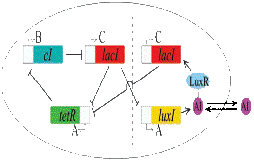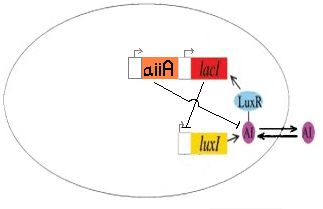McGill/Project Overview
From 2007.igem.org
| (7 intermediate revisions not shown) | |||
| Line 1: | Line 1: | ||
| - | == | + | == Future Directions == |
<u>'''Quorum-sensing coupled with the Repressilator'''</u> | <u>'''Quorum-sensing coupled with the Repressilator'''</u> | ||
| - | Our project is a continuation of one of the projects we presented last year: a two-gene oscillator, with an 'On' switch - LuxI gene, and an 'Off' switch - LacI, expressing a Cyan fluorescent protein when turned on for visualization. This simple relaxation oscillator makes a robust system of oscillations that can act as a 'pace maker' for more complicated oscillating systems. Quorum-sensing coupling between the systems is achieved with a diffusible artificial inducer (AI) protein | + | Our project is a continuation of one of the projects we presented last year: a two-gene oscillator, with an 'On' switch - LuxI gene, and an 'Off' switch - LacI, expressing a Cyan fluorescent protein when turned on for visualization. This simple relaxation oscillator makes a robust system of oscillations that can act as a 'pace maker' for more complicated oscillating systems. Quorum-sensing coupling between the systems is achieved with a diffusible artificial inducer (AI) protein (a tetramer composed of two LuxR and two LuxI) which binds to the Lux promoter to turn 'on' the system by promoting the synthesis of Lac. As Lac accumulates, it acts to turn 'off' the system by repressing the pLac controlling the synthesis of LuxI itself. Also, once AI is produced, it can easily diffuse to other cells and continue this 'On'-'Off' oscillator in other neighbouring cells, and hence increasing synchronization across a population of oscillating cells. |
<br><br> | <br><br> | ||
This year we've taken this system even further by adding several elements of control to see how they affect oscillations: | This year we've taken this system even further by adding several elements of control to see how they affect oscillations: | ||
| - | #Using Lac- Elowitz cells to | + | #Using Lac- Elowitz cells to obtain cleaner oscillations. |
#Synthesizing a new I15004 brick to meet our needs. | #Synthesizing a new I15004 brick to meet our needs. | ||
| - | # | + | #Changing cell densities and observing the effect on the oscillations. |
| - | #Adding an AI Analog (AHL) into the system. | + | #Adding an AI Analog (AHL) into the system and observing the effect on the oscillations. |
#Adding Tetracycline (DOX), an inhibitor of the LuxR promoter, to the system and observing its effect. | #Adding Tetracycline (DOX), an inhibitor of the LuxR promoter, to the system and observing its effect. | ||
#Adding an AI inhibitor (Aiia) into the system to control the levels of AI produced. | #Adding an AI inhibitor (Aiia) into the system to control the levels of AI produced. | ||
#Experimenting with cell divisions through an assay of optical density.<br> | #Experimenting with cell divisions through an assay of optical density.<br> | ||
<br> | <br> | ||
| - | A major enhancement to the system this year is that we plan on actually coupling the Ojalvo, Elowitz et al. - 'Represillator' system to the two-gene oscillator in a single cell. The Repressilator is a 3-gene repressing network | + | A major enhancement to the system this year is that we plan on actually coupling the Ojalvo, Elowitz et al. - 'Represillator' system to the two-gene oscillator in a single cell. The Repressilator is a 3-gene repressing network where each gene represses the other. This system produces oscillations but is hindered by noise and instability. We believe that this system can become highly stabilized if coupled with the 2-gene quorum-sensing oscillator, and once working side-by-side, the 2 systems will produce highly stable, smooth, sinusoidal oscillations.<br><br> |
| - | <center>[[Image:fullsystem.jpg]]<br> | + | <center>[[Image:fullsystem.jpg]]<br></center> |
<br><br> | <br><br> | ||
| - | Both the quorum-sensing Oscillator and the Repressilator, though observed | + | |
| + | It is also hoped that the addition of the aiiA (an AI degrader) gene under the lux pR will add stability to the oscillations by regulating AI levels inside the cell. | ||
| + | |||
| + | <center>[[Image:aiiAsystem.jpg]]<br></center> | ||
| + | |||
| + | <br><br> | ||
| + | |||
| + | Both the quorum-sensing Oscillator and the Repressilator, though observed on a cellular scale in our system, are important in helping understand time-varying conditions in the form of extrinsic driving forces from the environment and intrinsic rhythms generated within an organism itself. This includes specialized rhythm generators functioning in a coherent oscillatory state such as the cardiac pacemaker, also known as the sinoatrial node in mammalian hearts, and the circadian clock residing at the suprachiasmatic nuclei in mammalian brains. <br> | ||
<br> | <br> | ||
Latest revision as of 20:29, 26 October 2007
Future Directions
Quorum-sensing coupled with the Repressilator
Our project is a continuation of one of the projects we presented last year: a two-gene oscillator, with an 'On' switch - LuxI gene, and an 'Off' switch - LacI, expressing a Cyan fluorescent protein when turned on for visualization. This simple relaxation oscillator makes a robust system of oscillations that can act as a 'pace maker' for more complicated oscillating systems. Quorum-sensing coupling between the systems is achieved with a diffusible artificial inducer (AI) protein (a tetramer composed of two LuxR and two LuxI) which binds to the Lux promoter to turn 'on' the system by promoting the synthesis of Lac. As Lac accumulates, it acts to turn 'off' the system by repressing the pLac controlling the synthesis of LuxI itself. Also, once AI is produced, it can easily diffuse to other cells and continue this 'On'-'Off' oscillator in other neighbouring cells, and hence increasing synchronization across a population of oscillating cells.
This year we've taken this system even further by adding several elements of control to see how they affect oscillations:
- Using Lac- Elowitz cells to obtain cleaner oscillations.
- Synthesizing a new I15004 brick to meet our needs.
- Changing cell densities and observing the effect on the oscillations.
- Adding an AI Analog (AHL) into the system and observing the effect on the oscillations.
- Adding Tetracycline (DOX), an inhibitor of the LuxR promoter, to the system and observing its effect.
- Adding an AI inhibitor (Aiia) into the system to control the levels of AI produced.
- Experimenting with cell divisions through an assay of optical density.
A major enhancement to the system this year is that we plan on actually coupling the Ojalvo, Elowitz et al. - 'Represillator' system to the two-gene oscillator in a single cell. The Repressilator is a 3-gene repressing network where each gene represses the other. This system produces oscillations but is hindered by noise and instability. We believe that this system can become highly stabilized if coupled with the 2-gene quorum-sensing oscillator, and once working side-by-side, the 2 systems will produce highly stable, smooth, sinusoidal oscillations.

It is also hoped that the addition of the aiiA (an AI degrader) gene under the lux pR will add stability to the oscillations by regulating AI levels inside the cell.

Both the quorum-sensing Oscillator and the Repressilator, though observed on a cellular scale in our system, are important in helping understand time-varying conditions in the form of extrinsic driving forces from the environment and intrinsic rhythms generated within an organism itself. This includes specialized rhythm generators functioning in a coherent oscillatory state such as the cardiac pacemaker, also known as the sinoatrial node in mammalian hearts, and the circadian clock residing at the suprachiasmatic nuclei in mammalian brains.